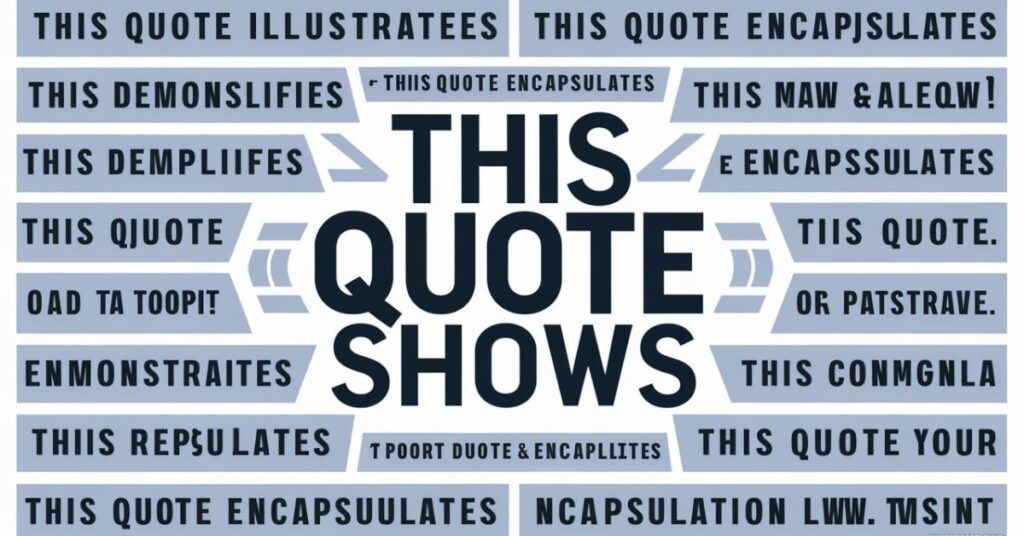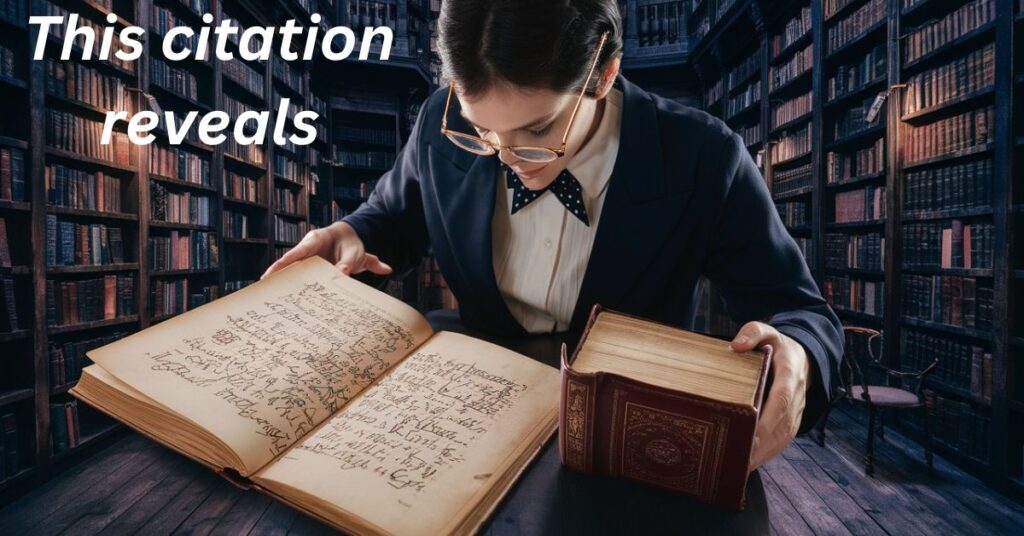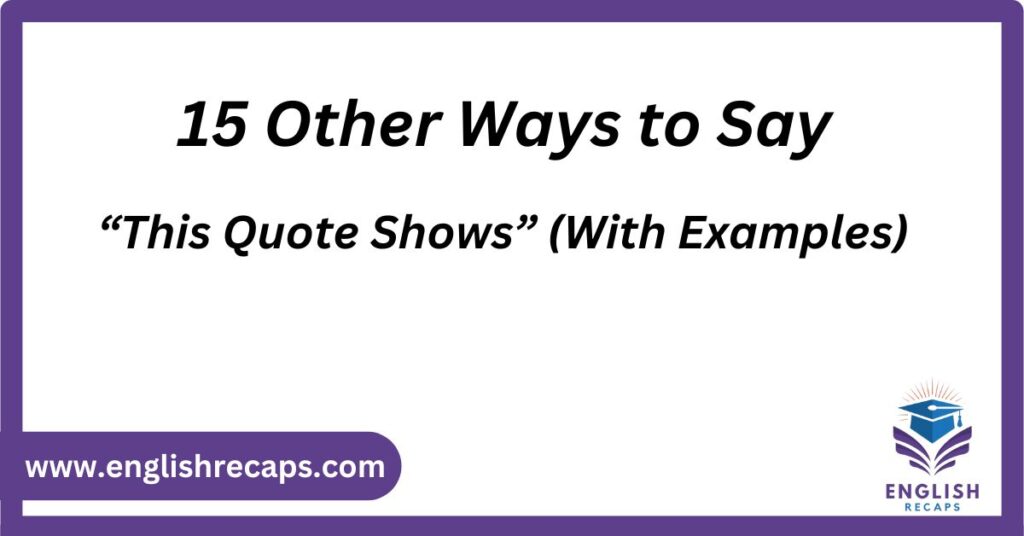Finding different other ways to say this quote shows can make your writing more interesting. It helps avoid repetition and adds variety to your explanations. Using new phrases also keeps your readers more engaged.
Are you tired of always writing “this quote shows”? It can get boring fast, right? But don’t worry. There are many other ways to express the same idea without sounding repetitive.
In this article, you’ll discover 15 other ways to say “this quote shows.” We’ll also provide examples to help you understand how to use these alternatives. These phrases will make your writing clearer and more lively.
What To Say Instead of “This Quote Shows”

- This excerpt illustrates
- The passage highlights
- This statement demonstrates
- These lines underscore
- This citation reveals
- The quote reflects
- This snippet exemplifies
- These words indicate
- The passage delineates
- This excerpt evidences
- The quote brings to light
- This statement emphasizes
- These words suggest
- This snippet clarifies
- The passage points out
Related Blog: 13 Other Ways to Say “Thank You for Your Attention”
1.This excerpt illustrates
This excerpt illustrates a great way to introduce a deeper understanding of a passage. It helps explain how a specific part of the text provides evidence for your point. This phrase adds clarity while avoiding repetition, making your writing smoother and more engaging.
Example:
“This excerpt illustrates the character’s internal struggle. When he says, ‘I can’t do this anymore,’ it shows his growing frustration and desire for change. The author uses this moment to highlight the emotional toll of his situation.
2.The passage highlights
The passage highlights an effective way to draw attention to important themes or details within a text. It helps emphasize key points the author is making. This phrase works well when you want to showcase a particular idea or element in a clear and concise manner.
Example:
“The passage highlights the importance of perseverance. When the protagonist refuses to give up, despite overwhelming odds, the author shows how determination can lead to success. This moment underlines the central theme of resilience.
3.This statement demonstrates
This statement demonstrates a powerful way to explain how a specific part of the text supports your interpretation or argument. It allows you to showcase the significance of an idea or fact in a clear and straightforward manner. This phrase is ideal for pointing out strong evidence within the text.
Example:
“This statement demonstrates the author’s belief in equality. When the speaker declares, ‘Everyone deserves a chance,’ it reflects their commitment to fairness. The author uses this line to stress the importance of inclusivity.
4.These lines underscore
These lines underscore is a strong way to emphasize a critical idea or theme within the text. It helps bring attention to the underlying message the author wants to convey. This phrase works particularly well when the text contains subtle but important points that need highlighting.
Example:
“These lines underscore the importance of family in difficult times. When the character says, ‘We’ll get through this together,’ it reflects the bond that keeps them strong. The author uses this moment to show the value of unity during hardship.
5.This citation reveals

This citation reveals is a great way to point out hidden details or deeper meanings in a text. It helps show how a specific part of the text uncovers significant insights or facts that may not be obvious at first glance. This phrase works well when you want to emphasize the underlying message or truth within the writing.
Example:
“This citation reveals the character’s inner conflict. When she says, ‘I’m not sure if I can trust anyone anymore,’ it hints at her growing mistrust. The author uses this moment to highlight her struggle with betrayal.
6.The quote reflects
The quote reflects is a useful way to show how a particular line mirrors the overall theme or emotional tone of the text. It helps connect the quote to broader ideas or personal feelings expressed by the author. This phrase works well when illustrating how a specific moment echoes a larger point.
Example:
“The quote reflects the uncertainty the protagonist feels. When they say, ‘I don’t know what tomorrow will bring,’ it captures the fear of an unpredictable future. The author uses this line to convey the character’s vulnerability and doubt.
7.This snippet exemplifies
This snippet exemplifies is an effective way to highlight a specific example that illustrates a broader concept or theme in the text. It points out how a particular portion serves as a representative instance of the author’s main ideas. This phrase is useful for demonstrating how specific details support general arguments.
Example:
“This snippet exemplifies the theme of personal growth. When the character reflects, ‘I’ve learned so much from my mistakes,’ it shows their journey toward self-improvement. The author uses this moment to underline the value of learning from challenges.
8.These words indicate

These words indicate a clear way to point out the implications or underlying messages conveyed by a specific part of the text. It helps to highlight what the author is subtly suggesting or revealing through their choice of language. This phrase is ideal for drawing attention to nuanced meanings or insights.
Example:
“These words indicate the character’s sense of isolation. When they say, ‘I feel like I’m on my own,’ it suggests a deep feeling of loneliness. The author uses this expression to emphasize the character’s emotional distance from others.
9.The passage delineates
The passage delineates is an effective way to describe how a section of text clearly outlines or defines specific aspects of a theme or character. It helps to show how the author maps out important details or boundaries within the narrative. This phrase is useful for explaining how a part of the text contributes to understanding key elements.
Example:
“The passage delineates the protagonist’s internal struggle. When the text describes his conflicting thoughts about leaving his hometown, it carefully outlines his emotional turmoil. The author uses this section to provide a detailed view of his dilemma.
You may wish to learn another related post: 25 Other Ways To Say: “Thanks For The Invite”
10.This excerpt evidences
This excerpt evidence is a strong way to point out how a particular part of the text serves as proof or support for a key argument or theme. It helps to show that specific details or statements within the excerpt provide clear evidence for a broader point being made. This phrase is useful for highlighting supporting information.
Example:
“This excerpt evidences the growing tension between the characters. When the dialogue reveals their heated argument, it clearly supports the conflict driving the plot. The author uses this moment to provide concrete proof of the escalating discord.
11.The quote brings to light
The quote brings to light an effective phrase for revealing important insights or underlying truths within the text. It helps to uncover new perspectives or details that might not be immediately obvious. This expression is useful for highlighting revelations or significant points that are central to understanding the text.
Example:
“The quote brings to light the character’s hidden fears. When they confess, ‘I’m afraid of what I can’t control,’ it reveals their deep-seated anxieties. This line sheds light on their internal struggles and the root of their apprehensions.
12.This statement emphasizes

This statement emphasizes a powerful way to draw attention to a key point or theme within the text. It helps underline the significance of a particular idea or argument by highlighting its importance. This phrase is effective for showing how specific statements reinforce the main message or focus of the text.
Example:
“This statement emphasizes the theme of personal sacrifice. When the character says, ‘I would do anything for my family,’ it underscores their willingness to put others’ needs before their own. The author uses this line to stress the depth of the character’s commitment.
13.These words suggest
These words suggest a subtle way to hint at deeper meanings or underlying themes within the text. It helps to point out what the author might be implying or alluding to beyond the surface level. This phrase is effective for drawing attention to the implied significance of specific language or phrasing.
Example:
“These words suggest a sense of nostalgia. When the character says, ‘I remember when things were simpler,’ it hints at their longing for the past. This choice of words implies a deeper emotional connection to earlier, more carefree times.
14.This snippet clarifies
This snippet clarifies is a precise way to explain how a specific part of the text makes a concept or detail more understandable. It helps to show how the excerpt provides additional information or resolves ambiguity. This phrase is useful for highlighting how particular sections enhance the reader’s comprehension.
Example:
“This snippet clarifies the protagonist’s motivation. When the text describes their desire to ‘prove everyone wrong,’ it reveals the driving force behind their actions. This detail helps to explain their intense determination and personal stakes.
15.The passage points out
The passage points out is a straight forward way to highlight specific aspects or observations made in the text. It helps to direct attention to important details or messages that the author is making. This phrase is effective for emphasizing how certain sections draw attention to key elements or insights.
Example:
“The passage points out the significance of loyalty in relationships. When it states, ‘True friends stand by you through thick and thin,’ it highlights the value of unwavering support. This line underscores how central loyalty is to the story’s theme.
Conclusion
Exploring “15 Other Ways to Say This Quote Shows (With Examples)” helps make writing more engaging and varied. Using different phrases keeps your writing fresh and prevents repetition. It also allows you to express ideas more clearly and precisely.
By applying these alternatives, you can enhance the way you present quotes and information. This approach not only improves the quality of your writing but also makes it easier for readers to understand your points. Each phrase offers a unique way to highlight and emphasize the meaning of quotes, adding depth to your work.
FAQ’s
What to say instead of this quote shows that?
Instead of “this quote shows that,” try “this quote illustrates” or “this statement reveals.” These phrases add variety and clarity to your writing.
What is another way of saying “this shows that”?
Another way of saying “this shows that” is “this indicates that.” It provides a clear alternative while emphasizing the connection between the evidence and the conclusion.
How to explain a quote without saying this shows?
To explain a quote without saying “this shows,” you can use phrases like “this highlights” or “this reveals.” These alternatives effectively convey the quote’s significance and underlying meaning.
What can you say instead of the quote?
Instead of saying “the quote,” you can use “this excerpt” or “this passage.” Both terms help specify the part of the text you’re referring to with greater precision.
How do I introduce a quote?
To introduce a quote, use phrases like “according to” or “as stated by.” These openings provide context and smoothly integrate the quote into your writing.
To wish someone a happy birthday in Marathi, say “वाढदिवसाच्या शुभेच्छा!” This translates to “Happy Birthday Wishes in Marathi!” Use this phrase to express your heartfelt wishes and celebrate their special day.


